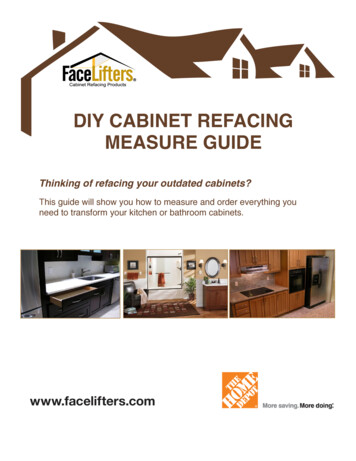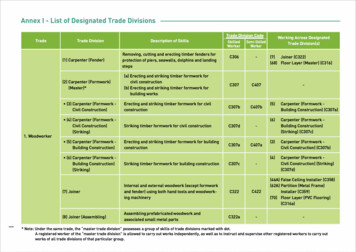
Transcription
The Joiner and Cabinet Maker
The JoinerandCabinet MakerHis WorkAnd its Principles“Whatever thy hand findeth to do, do it with thy might.”Ecclesiastes ix. 10.ENLARGED EDITION WITH ILLUSTRATIONSby Anon,Christopher Schwarz &Joel Moskowitz
First published by Lost Art Press LLC in 200926 Greenbriar Ave., Fort Mitchell, KY, 41017, USAWeb: http://lostartpress.comTitle: The Joiner and Cabinet Maker: His Work and its PrinciplesAuthors: Anon, Christopher Schwarz and Joel MoskowitzEditor: Christopher SchwarzCopy editors: Megan Fitzpatrick, Lucy MayCover: Timothy CorbettSpecial thanks to Jeffrey Peachey for his chapter:“Contextualizing ‘The Joiner and Cabinet Maker’”Copyright: Part 1, all notes in Part 2, and “Epilogue” chapter areCopyright 2009 by Joel Moskowitz. Part 3 text is Copyright 2009 by Christopher Schwarz.ISBN: 978-0-578-03926-8Second printing.ALL RIGHTS RESERVEDNo part of this book may be reproduced in any form or by anyelectronic or mechanical means including information storage andretrieval systems without permission in writing from the publisher;except by a reviewer, who may quote brief passages in a review.This book was printed and bound in the United States.
ContentsPart I: HistoryIntroduction Page 7 England in 1839 Page 11 Part II: The Original Text“The Joiner and Cabinet Maker” Page 45 1883 Supplement to “The Joiner and Cabinet Maker” Page 144 Part III: ConstructionIntroduction Page 155 On the Trade Page 159 The Packing Box Page 171 The Schoolbox Page 203 The Chest of Drawers Page 261 Part IV: Further ReadingEpilogue Page 347 Bibliography Page 351 Contextualizing “The Joiner and Cabinet Maker” Page 357 Appendix Page 368
AcknowledgementsResearch, writing, and working in wood are never done well in avacuum. I need to thank some people for their help in getting thisbook to a wider audience.Maurice Fraser, who taught me most of what I know about hand toolsand also instilled a sense of history and tradition in my work.Christopher Schwarz, whose interest in hand tools and traditionalwork has revitalized the hand-tool market, and whose ability to writecompulsively, engagingly and intelligently on woodworking enabled himto do the heavy lifting on this project, in addition to his full-time job aseditor of two magazinesMost of all my wife, Sally Bernstein, who not only functions as myeditor, but without her support I would still be just sweeping up shavings.— Joel MoskowitzIdon’t write books for a living, so writing books takes its toll on thepeople in my life. So to Lucy, Maddy and Katy: Thank you for ninemonths of patience at my absence from school events, the sledding hill,the pool and the couch. This book, and the rest of this year, are for you.— Christopher Schwarz
7Part I: HistoryIntroductionIn 1839, an English publisher issued a small book on woodworkingthat has – until now – escaped detection by scholars, historians andwoodworkers.Titled “The Joiner and Cabinet Maker,” this short book was writtenby an anonymous tradesman and tells the fictional tale of Thomas, alad of 13 or 14 who is apprenticed to a rural shop that builds everythingfrom built-ins to more elaborate veneered casework. The book waswritten to guide young people who might be considering a life in thejoinery or cabinet making trades, and every page is filled with surprises.Unlike other woodworking books at the time, “The Joiner andCabinet Maker” focuses on how apprentices can obtain the basic skillsneeded to work in a hand-tool shop. It begins with Thomas tendingthe fire to keep the hide glue warm, and it details how he learns stockpreparation, many forms of joinery and casework construction. It endswith Thomas building a veneered mahogany chest of drawers that isFrench polished.Thanks to this book, we can stop guessing at how some operationswere performed by hand and read first-hand how joints were cut andcasework was assembled in one rural English shop.Even more delightful is that Thomas builds three projects during thecourse of his journey in the book, and there is enough detail in the textand illustrations to re-create these three projects just as they were builtin 1839.
88"20"Profile View (Section)
Introduction9When we first read this book, we knew we had to republish it. Simplyreprinting the book would have been the easy path, however. What wedid was much more involved.We have published “The Joiner and Cabinet Maker” with additionalchapters that will help you understand why the book is important,plus details that will make you a better hand-tool woodworker. In thisexpanded edition, you’ll find: A historical snapshot of early 19th-century England. Moskowitz, abook collector and avid history buff, explains what England was like atthe time this book was written, including the state of the labor force andwoodworking technology. This dip into the historical record will expandyour enjoyment of Thomas’s tale in “The Joiner and Cabinet Maker.” The complete text of “The Joiner and Cabinet Maker,” unabridgedand unaltered. We present every word of the 1839 original (plus achapter on so-called “modern tools” added in a later edition), withfootnotes from Moskowitz that will help you understand the significanceof the story. Chapters on the construction of the three projects from “TheJoiner and Cabinet Maker.” Schwarz built all three projects – a PackingBox, a dovetailed Schoolbox and a Chest of Drawers – using handtools (confession time: he ripped the drawer stock on a table saw). Hischapters in this new edition of “The Joiner and Cabinet Maker” showthe operations in the book, explain details on construction and discussthe hand-tool methods that have arisen since this book was published. Complete construction drawings and cut lists for the modernwoodworker. This will save you the hours we spent decoding theconstruction information offered in “The Joiner and Cabinet Maker.”We encourage you to read this entire book and attempt to build thethree projects using hand tools. That is a tall order, we know. However,building the Packing Box, the Schoolbox and the Chest of Drawers willunlock the basic skills needed for all hand-tool woodworking, and itwill offer insights into how traditional, high-quality casework was reallybuilt.— Christopher Schwarz & Joel Moskowitz
10The Joiner and Cabinet MakerThese are some of the tools of the joiner shown in “Spons’ Mechanics’ Own Book”(1885).
170“But ‘ it will do’ is a very bad maxim, especially for a person learning abusiness; the right principle is to ask oneself, ‘ is it as good as it can be made?’or, at least, ‘ is it as good as I can make it?’ ”— “The Joiner and Cabinet Maker”
171Part III: ConstructionThe Packing BoxIt’s easy to dismiss the Packing Box built for Mr. Green as too simplea project for even a beginning joiner. It is, after all, a crude box madewith a gross of nails.However, I urge you to build the Packing Box. If you follow alongwith Thomas (as I did), there is remarkable stuff to learn here abouthand work that is rarely discussed in modern texts.Hand-tool woodworking is different than power-tool woodworking.With power tools it’s simple to size your parts exactly then assemblethem so every corner is flush and perfect when the clamps come off.When working with hand tools, this is neither easily achieved noris it a good idea. With hand tools, parts can (and should) be irregularwidths and lengths. After the parts are assembled, the box is trued upwith a plane afterward.In the end, both approaches result in the same sturdy and goodlooking box. However, you have to be careful about how you mix powertools and hand tools. While they can play nicely together, you also canmake a lot of fussy work for yourself by sizing all your parts to within.001" in length on a shooting board with a plane before assembly. That’sa waste of your effort.Mr. Green’s Packing Box also will teach you how to become adeptwith a full-size handsaw to break down your stock (something that mostof us need practice with), which will prepare you for the backsaw workwhen building the next project, the dovetailed Schoolbox.
172The Joiner and Cabinet MakerAnd lastly, you’ll get an education in cut nails and clinching. Thisproject requires a whole handful of cut headless brads that are installedin a variety of ways that will teach you how to avoid splits, how to workrapidly and how to clinch the buggers, which is immense fun.So if you were thinking of skipping the Packing Box, pleasereconsider. Here’s some bait: You get to buy a new tool, the two-footrule. That’s the tool that Thomas and Mr. Jackson use to pick the stockfor the Packing Box. You also get to learn a good deal about deal, whichis the wood used throughout “The Joiner and Cabinet Maker.”Rules, Deals and ChalkThe two-foot rule was the standard measuring device for woodworkingfor hundreds of years. The steel tape was likely invented in the 19thcentury. Its invention is sometimes credited to Alvin J. Fellows of NewHaven, Conn., who patented his device in 1868, though the patentstates that several kinds of tape measures were already on the market.Tape measures didn’t become ubiquitous, however, until the 1930sor so. The tool production of Stanley Works points this out nicely. Thecompany had made folding rules almost since the company’s inceptionin 1843. The company’s production of tape measures appears to havecranked up in the late 1920s, according to John Walter’s book “StanleyTools” (Tool Merchant).The disadvantage of steel tapes is also their prime advantage: Theyare flexible. So they sag and can be wildly inaccurate thanks to thesliding tab at the end, which is easily bent out of calibration.What’s worse, steel tapes don’t lay flat on your work. They curl acrosstheir width enough to function a bit like a gutter. So you’re alwayspressing the tape flat to the work to make an accurate mark.Folding two-foot rules are ideal for most cabinet-scale work. They arestiff. They lay flat. They fold up to take up little space. When you placethem on edge on your work you can make an accurate mark.They do have disadvantages. You have to switch to a different toolafter you get to lengths that exceed 24", which is a common occurrencein woodworking. Or you have to switch techniques. When I lay outjoinery on a 30"-long leg with a 24"-long rule I’ll tick off most of thedimensions by aligning the rule to the top of the leg. Then – if I haveto – I’ll shift the rule to the bottom of the leg and align off that. Thistechnique allows me to work with stock 48" long – which covers about95 percent of the work.
The Packing Box173Here I’m using a zig-zag rule and a carpenter’s pencil to lay out the cuts on the pinestock for the Packing Box. I dislike zig-zags for this work because they don’t lay flat.They have the precision of a hand grenade.Other disadvantages: The good folding rules are vintage and typicallyneed some restoration. When I fixed up my grandfather’s folding rule,two of the rule’s three joints were loose – they flopped around like whenmy youngest sister broke her arm. To fix this, I put the rule on my shop’sconcrete floor and tapped the pins in the ruler’s hinges using a nail set
174The Joiner and Cabinet MakerOne leg of this scale has been cleaned with lanolin. The other has been wiped withwood bleach, which lightened the boxwood but didn’t affect the markings.and a hammer. About six taps peened the steel pins a bit, spreadingthem out to tighten up the hinge.Another problem with vintage folding rules is that the scales havebecome grimy or dark after years of use. You can clean the rules with alanolin-based cleaner such as Boraxo. This helps. Or you can go wholehog and lighten the boxwood using oxalic acid (a mild acidic solutionsold as “wood bleach” at every hardware store).Vintage folding rules are so common that there is no reason topurchase a bad one. Look for a folding rule where the wooden scalesare entirely bound in brass. These, I have found, are less likely to havewarped. A common version of this vintage rule is the Stanley No. 62,which shows up on eBay just about every day and typically sells for 20or less.The folding rule was Thomas’s first tool purchase as soon as Mr.Jackson started paying him. I think that says a lot about how importantthese tools were to hand work.When marking out his stock, Thomas uses chalk in conjunction withthe rule. The author also notes that Thomas always has chalk in hispocket. What gives?Chalk is ideal for marking out coarse measurements on boards
The Packing Box175because it won’t snap like a pencil lead on a rough-sawn wooden surface.It’s also far easier to see than pencil lead. In my shop, I’ve always usedchalk at every stage in construction. You can make very bold (but easilyremoved) marks on your parts to keep them organized. I also use chalkto mark all the areas of tear-out that need to be addressed on a nearlyfinished piece of work. (Does chalk dull your edge tools? I haven’t had aproblem.)I also like how the chalk dust in my pocket absorbs excess moistureon my hands, which is a trick from the rock climbing and billiards set.The third unfamiliar thing at this stage of the book is the way theauthor throws around the word “deal.” It’s easy to get the impressionthat deal is merely an English word for dimensional pine. But if youdig around, it can become confusing. “The Joiner and Cabinet Maker”instructs you to build one project using either “pine or deal.”Huh? Let’s hit the books.In my library, the accounts I dug up all agree that a “deal” is a plankof pine or spruce that is 9" wide. But they disagree on the thickness.According to Bernard E. Jones’s “Practical Woodworker” (10 SpeedPress), deal is 9" wide and no more than 4" thick. Charles H. Hayward’s“Carpentry for Beginners” (Drake) agrees that deal is 9" wide, butsays the thickness is between 2" and 4". And Paul N. Hasluck’s “TheHandyman’s Book” (Senate) states that deal is 9" wide and 2-1/2" thick.What is also helpful to know is that deal is just one word that Englishbooks use to describe standard sizes of wood. According to Hayward, a20th-century author, here are some others:Plank: A piece of wood that is 11" wide or wider and 2" to 4" thick.Batten: A piece of wood that is 5" to 8" wide and 2" to 4" thick.Board: Anything that is more than 4" wide and less than 2" thick.This term is usually used with floorboards and tongued-and-groovedboards.Scantling: Small bits that are 2" to 4-1/2" wide and 2" to 4" thick.Strip: Pieces that are less than 4" wide and less than 2" thick.But that’s not all. There are different kinds of deal. Deal that isNorthern pine (Pinus sylvestris) can be called Baltic red deal, Dantzicdeal or yellow deal. And Spruce (Picea excelsa) shows up as white deal.And Canadian spruce (Picea nigra) can be called New Brunswick sprucedeal.
176The Joiner and Cabinet MakerSawbenches make this work much easier. These flat-topped shop appliances are aboutas high as your knee. They allow you to hold your work without any clamps. My leftknee is holding the stock firmly to the sawbench. My right knee is braced firmly againstthe edge of the stock.The author of “The Joiner and Cabinet Maker” uses the word dealto describe a piece of wood that is about 9" wide and that comes in avariety of thicknesses. The wood that Thomas uses is called “half-inchdeal.” That means it came into his hands already 1/2" thick, and he
The Packing Box177didn’t have to plane it down from 4/4 stock – an important detail toremember as you explore hand work. Don’t thickness stock more thanyou have to.One more detail: The master gives Thomas five hours to build thebox. If you’re still not sold on building the Packing Box yourself, youmight consider timing yourself. What case work project can really becompleted in five hours?Laying Out and SawingWhen laying out the cuts on the deal, Thomas allows himself an extra1/4" to account for the waste in sawing, which accounts for the kerf andany wandering off the line. This is less than the 1" typically allowedin machine work. If you abide by this guideline you need to be carefulabout looking for splits at the ends of the boards. If you don’t abide bythis 1/4" guideline, don’t sweat it. The master gave Thomas an extra 1"at the end of his boards.When Thomas goes to work at the bench, he finds that things arein disarray. Sam, the villain of this book (who we don’t actually get tomeet), has left the workbench a mess. The tools are everywhere and thebench is covered in shavings.Thomas cleans the bench. It might seem that this is an episodeof “The Anal Retentive Joiner,” but it’s not. Cleaning up your workarea before you begin is good practice – you don’t waste time lookingfor a tool buried under piles of tools. And, amongst good tradesmen,orderliness is prized.I once judged a contest put on by the Robert Bosch Corp., a Germancompany with deep roots in the country’s apprentice system. In thiscontest, the best student woodworkers and trim carpenters had beenbrought together to compete for an impressive prize of money and tools.The students were given a plan and told to build the project in one day.The judges watched the entire construction process – we weren’t therejust to judge the resulting project.The Bosch officials were interested in how the students conductedthemselves. Did they use safe practices? Did they work in an orderlymanner? How did they treat their tools? Was their working pace steadybut deliberative? Did they clean their work area as they proceeded?In other words, it wasn’t a race to see who could finish first. Or whocould make the most impressive wooden object. It was a race to be thebest all-around tradesman.
178The Joiner and Cabinet MakerIt was a very unusual contest to hold in the United States.In any case, Thomas goes about putting his work area in order beforehe begins. What is remarkable to me is that this occurs right after Mr.Jackson gives him a firm deadline for completing his work. Thomasknows that a little cleaning will save time at the end.‘So He Sets to Work With Good Heart to Make the Box’The first step to making the Packing Box is to knock down yourstock into manageable lengths. The best way to do this is with a pairof sawbenches and a handsaw. Every hand-tool shop needs a pair ofsawbenches as handsaws are awkward to use at workbench height.Sawhorses will suffice in a pinch, but the wide top of a sawbench issuperior.Handsaws are also a constant companion in a hand-tool shop, andselecting one is an important task. For breaking down stock, I like asaw that has 7 or 8 points per inch (ppi). Typical handsaws have a 26"long blade, though many cabinet makers like using panel saws in a shopenvironment, which have a blade that is more like 20" long.Either saw length will work fine, though you will find it easier to findthe more common 26" handsaw, so they are less expensive.As to the shape of the teeth, there is some debate amongstwoodworking historians as to what Thomas might have used circa 1839.Some woodworkers contend that saws during the 18th and early 19thcenturies were likely all filed with a rip tooth, which is where the frontcutting face of each tooth is filed at 90 to the sides of the tooth.Others contend that woodworkers of this era would surely have heardof and used the “fleam” tooth, which is where the cutting face of eachtooth is angled a bit, which makes for a cleaner crosscut.Thomas uses all his saws for both ripping and crosscutting operations,so that is some support for the hypothesis that all the saws were filedwith one (likely rip) configuration. But as someone who has handsharpened saws, let me offer another theory: These saws were filed withsome fleam, and that fleam was the result of filing a saw by hand.Yup, if you’ve ever tried to file a rip saw by hand, you’ve probablynoticed that it’s almost impossible to file the face of every tooth at 90 without introducing a little bit of fleam. And even a little fleam makes asaw cut more smoothly – especially when you have variable fleam, whichis what you get when you sharpen a saw by hand.So now you have a saw that will do the job. You’ve marked your
The Packing Box179Shown is one common pattern for a sawbench. Note the flat top that is about 7" wideand the height of the bench, which is just below the worker’s knee.crosscut with a carpenter’s pencil or with a striking knife. Your rips aremarked with chalk. So how do you begin to saw?Sawing is one of the most important woodworking skills. Learning toplane or nail is no big deal compared to learning to saw. So what do youneed to know to become a good sawyer? There are several suggestions Ican make that will immediately ensure you become a better sawyer. Herethey are:1. Use a three-fingered grip. Extend your index finger when sawing.Never use a four-fingered grip, even if a misshapen tool tote allows fourdigits inside. All sawing is supposed to be done with three fingers on thetote and your index finger extended out, which tells your body: “Do thisoperation so things are straight.”2. Never clutch the tote nor use more than a tad of downwardpressure when sawing. Both of these muscular missteps will take you offyour line in a hurry. A good saw wants to cut straight, and a good sawyerknows to get out of its way and let the tool do its job.3. Take long, even strokes (fool yourself into thinking the sawplateis longer than it really is) and lift the saw slightly on the return stroke.This helps clear your line of sawdust and reduces the huffing you’ll do.
180The Joiner and Cabinet MakerBegin your cut with the saw pitched low (at top). This lower angle makes the tool easierto start. When you are sawing sweetly, raise the saw (45 for crosscut saws and 60 forrip saws). This makes the cut more aggressive.
The Packing Box181Thomas used a brad awl to secure one end of the chalk line. A nail or a helper monkeyare other good options (speaking as a former helper monkey).4. Correcting a wayward sawcut is a subtle thing. If you drift off line,try to correct your cut by making a couple strokes while you slightly twistthe tote toward the line. Then relax your grip and take a couple normalstrokes. All saws lag a bit in responding to directions from the user. It’seasy to over-compensate.5. A shiny saw will help ensure that your cut is true as you progress.Observe the reflection of your work in the sawplate. When the reflectionis a perfect mirror of your work, then the saw is straight and plumb.6. Mark your cutline across the width and the thickness of yourwork and always work so you can see your lines. Never let the sawplateobscure your pencil or knife line. You might have to move your head toan awkward place to see your lines, but that’s OK.Learning to rip a long board is more difficult than learning tocrosscut. Thomas has to rip a long board to improve the yield of hismaterial and get all the Packing Box’s cross-strengtheners he needs fromthe waste that will fall away.Ripping can be tricky and tedious, so it’s best to have a good line towork to. Thomas lays out a chalk line. I haven’t used a chalk line sinceI left the farm in Arkansas, but I was happy to get reacquainted with thechalk-line tool (and buy a cool bottle of chalk dust).
182The Joiner and Cabinet MakerIf you don’t have a five-hour stretch to devote to building the packing box, it’s likely thatyou will have to leave your stock sitting out overnight. As recommended in the book,you want to keep the air circulating around the boards. I sticker my parts when I leavethem overnight. This reduces cupping and winding.Snapping a chalk line is a more reliable way to get a straight lineon rough stock than using a panel gauge. And when your edges areunreliable as reference surfaces, chalk is the way to go.When you rip a board, take your time at the outset. And raise thesaw up high – a 60 angle is faster, and you won’t get the same blow-outthat you’d get by using this high angle in a crosscut. Eventually, you’llbecome a ripping machine (or you’ll buy a band saw).Onto the PlanesWith the pieces sawn to length, it’s time to dress the ends and faces ofthe boards with your planes. “The Joiner and Cabinet Maker” mentionsthree bench planes: a trying plane, a jack and a smoothing plane. Thetrying plane is the longest of the three planes and is used for shootinglong edges straight and flattening large panels. In some shops, this iscalled the jointer plane.The jack is used for coarse stock removal, shooting shorter edges andflattening smaller panels. It is sometimes called the fore plane, and istypically 14" to 18" long.
The Packing Box183These three bench planes are the heart of the hand-tool workshop, though some woodworkers get by with only one or two of them. At top left is a trying plane (sometimescalled a jointer). To the right is a smoothing plane. At the front is a typical jack plane.The smoothing plane is a short plane, usually about 10" long or less(older wooden ones are typically shorter than modern metal ones). Theyare used for the final dressing of the stock.Throughout this project Thomas makes do with a borrowed jackplane and a smoothing plane, and you can, too. The jack plane’s ironshould have a slight curve to its edge to prevent the corners from digginginto the wood. The marks left by the corner of an iron can be called“tracks” or “gutters.”A wide range of curvatures will work with a jack plane, whichtypically has a 2"-wide iron. An 8"- or 10"-radius curve will serve well,though some woodworkers will use a flatter curve.For the smoothing plane, you can sharpen its cutting edge with aslight curve that you create with a little extra finger pressure at thecorners of the tool as you sharpen it. Or you can sharpen the ironstraight and just feather back the corners with a fine file. In the end,what matters is that the plane leaves a surface that is free of gutters.The jack plane sees a lot of use in “The Joiner and Cabinet Maker,”and it is a workhorse in a hand-tool shop. I have both wooden- andmetal-bodied planes and like them both. These are great planes for
184The Joiner and Cabinet MakerWooden-bodied planes all work the same. The most important thing to remember is totap the back of the plane’s wedge every time you make an adjustment to the iron. Tapthe back of the iron to increase the cut. Then tap the wedge. Tap the side of the ironto adjust the cutter laterally. Tap the wedge. Rap the heel of the tool to reduce the cut.Tap the wedge.Note the hand positioning here. The left hand is a fence to keep the tool square to theface of the board. The right hand pushes the tool forward (note the three-finger grip).
The Packing Box185One of the biggest errors beginners make when planing by hand is they take too thin ashaving. Thin shavings are great for smoothing planes. The other planes should takethicker shavings. Here you can see the gnarly curlies my jack spits out.beginners because they are common, inexpensive and forgiving when itcomes to setting them up.While a smoothing plane and a trying plane require a flat sole towork well, the jack gets by without this fussing because it usually takesa substantial shaving. It still needs to be fairly flat, but you don’t haveto get out the feeler gauges and machinist granite plates to get the jobdone.Once you get your jack working well, you want to set it to take asubstantial shaving, which should look like the ribbon on a birthdaypresent as it curls out of the tool’s mouth. That thick-ish shaving will getthe job – cleaning up your hand-sawn edges – done in a jiff.Once you have an edge that is straight, take the board out of the viseand use your panel gauge to mark the final width of the board. A panelgauge works like a typical marking gauge except the beam is longer andthe head is wider. A panel gauge can have either a needle-like pin or aknife as a cutter. The pin is less likely to wander than a knife is, but aknife leaves a sharper line. The trick to using a knife in a panel gauge is touse several gentle passes to make your mark instead of one mighty stroke.When I’m working with rough stock, I’ll use a panel gauge that can
186The Joiner and Cabinet MakerHere is a panel gauge with a pencil installed. You can alter any panel gauge to accept apencil by drilling a hole and a slot near the end of the beam (be sure to drill in the endthat doesn’t have the pin or knife). Then use a screw to pinch the slot and hole aroundthe pencil.Check your work with a straightedge. Wooden straightedges are lighter, inexpensiveand can be any length you please. Note the traditional shape: The beveled top exposesmore end grain. I have found that this shape allows the tool to respond easily tochanges in humidity.
The Packing Box187Check your edge with a try square in at least three places as well. If your edge is true tothe straightedge and the try square then it is tried and true.accept a pencil because the pencil line is easier to see than a knife lineor pin scratch.Then work the edge of your board down to the line left by your panelgauge. If you pay attention to the shavings emerging from your plane,you’ll actually see the shaving’s edges become a little ragged as you hityour knife or pin line, especially if you left a nice, deep mark. When yousee this raggedness, stop planing.With the long edges planed, it’s time to dress the ends of the two endpieces. A shooting board is one way to achieve a true end; however, inthis instance Thomas does without. It might sound a bit nuts to dressa board’s end with just a smoothing plane and a pencil line, but that’sbecause you’ve never tried it.You don’t need a fancy shooting board or special plane to do thiswork. A sharp, fine-set plane and a good eye will get you by. In the futurechapters, we’ll discuss and use a shooting board, but for this project – arough box – I encourage you to give it a go freehand.You will be surprised how a trained eye can discern straight andsquare at a glance. You only have to se
Unlike other woodworking books at the time, “The Joiner and Cabinet Maker” focuses on how apprentices can obtain the basic skills needed to work in a hand-tool shop. It begins with Thomas tending the fire to keep the hide glue warm, and it details how he learns stock preparation,










